| Greeting | Indigenous Language | English Meaning |
|---|---|---|
| Aanii | Anishinaabemowin | Hello / how are you / how is life going (friend greeting) |
| Biindigen | Anishinaabemowin | Welcome, come in |
| Boozhoo | Anishinaabemowin | Hello (formal greeting) |
| Halu | Inuktitut | Hello / Greetings |
| KweyKwey | Oji-Cree | Hello |
| Oki | Blackfoot | Welcome / Greetings |
| Pusu’l(pronounced Bu-suul) | Mi’kmaq | Hello / Greetings |
| She:koli | Oneida | Hello / Greetings |
| She:kon | Mohawk | Hello / Greetings |
| Tansi | Cree | Friendly greeting |
| Tawnshi | Métis (Michif) | Hello |
| Tawow | Plains Cree | Welcome /There’s always room |
| Tunngasugit | Inuktitut | Welcome |
| Wachay | Swampy Cree | Hello / Goodbye |
Art at YKF
 The Region of Waterloo International Airport is committed to providing a world-class passenger experience. In keeping withhigh industry standards, YKFfeatures artwork by local, internationally renowned artists.
The Region of Waterloo International Airport is committed to providing a world-class passenger experience. In keeping withhigh industry standards, YKFfeatures artwork by local, internationally renowned artists.
ART YKF installations are located throughout the airport. Each includes a brief description and QR code you can scan to learn more. Enjoy!
Current Installations
Indigenous Languages Greetings Wall (Open to all — no boarding pass required!)
Honouring These Lands and Waterways Murals(Open to all — no boarding pass required!)
- Memory and the Temporal Exchange(Open to all — no boarding pass required!)
Field of Winds(Open to all — no boarding pass required!)
- Ohontsà:ke nitioné:non onkwakara’shón:’a - Our Stories from the Land(Restricted - valid boarding pass required)
Indigenous Languages Greetings Wall
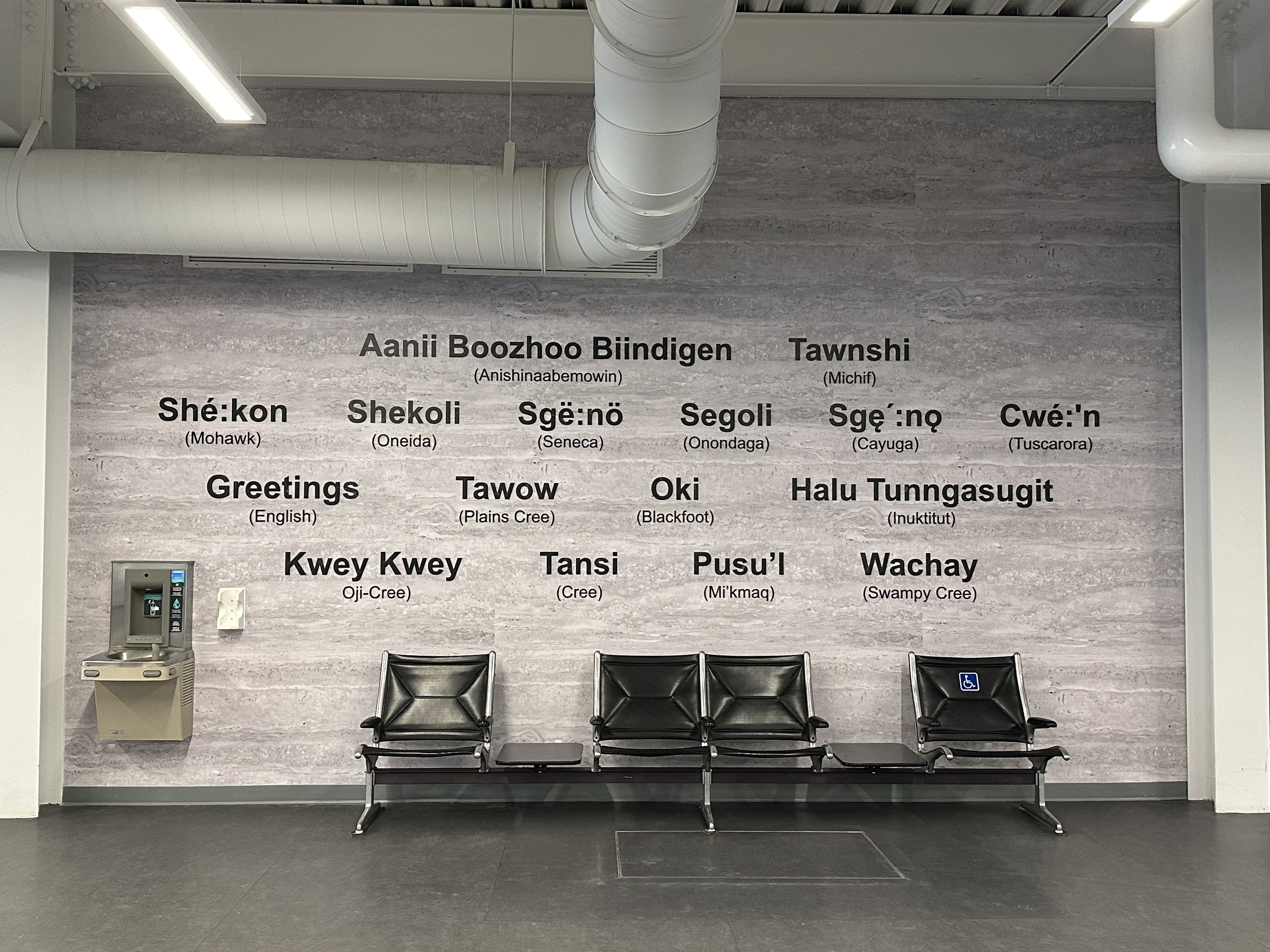
Aanii, Boozhoo, She:kon, Tansi, Welcome! As you arrive at the Region of Waterloo Airport domestic arrivalsyou will be welcomedwith a new sign offering greetings inIndigenous languages spoken within the Region of Waterloo. This initiative reflects our commitment to inclusivity, cultural awareness, and the recognition of the important roleIndigenous communities play in our shared history and future.
This sign carries a message of both education and change. Each of the languages is spoken in the Region of Waterloo by various Indigenous Peoples across Turtle Island that now call the Region of Waterloo home.
Hearing and learning Indigenous languages is vital in Canada because these languages carry the history, culture, and worldview of Indigenous peoples, fostering reconciliation and mutual understanding.
Within the Truth and Reconciliation Commission of Canada: Calls to Action, there are 5 calls directly related to language and culture. Call 14.i says, “Aboriginal languages are a fundamental and valued element of Canadian culture and society, and there is an urgency to preserve them.” We agree and celebrate the preservation and use of Indigenous languages in our community spaces.
This wall stands as a powerful symbol of change, marking a shift away from a history where Indigenous languages were silenced and unwelcome in government spaces. Today, it reflects our commitment to creating a space that welcomes First Nations, Inuit, and Métis Peoples by honoring their languages. This gesture is one of the meaningful ways we are advancing Truth and Reconciliation here in the Region of Waterloo, opening our doors to inclusivity, respect, and shared understanding.
We invite you to take time to visit the sign, learn greetings in these Indigenouslanguages, and reflect on your own Truth and Reconciliation journey.
Honouring These Lands and Waterways Murals
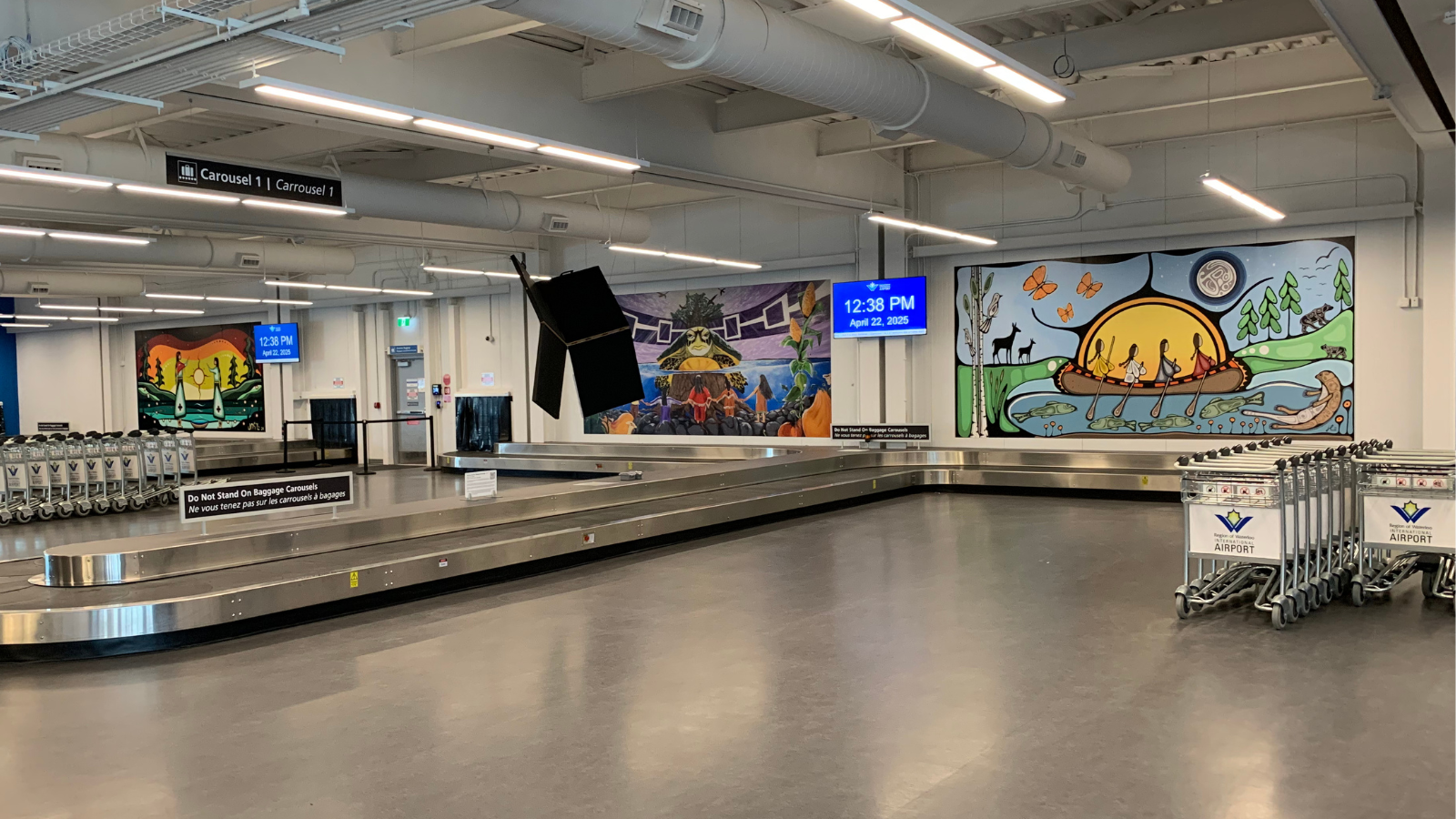 Three Indigenous artists have been selected to have their work displayed in the Domestic Arrivals Building at YKF. The selected artists include Jeannette Ladd, an Anishinaabe artist from Saugeen First Nation,Judy Ross Mack, an Urban Indigenous artist of Swampy Cree heritage from Weenusk First Nationand Cheyenne Ricard, a Haudenosaunee artist of Mohawk and Tuscarora descent. The murals, under the theme "Honouring These Lands and Waterways," reflect the rich cultural heritage, resilience, and diverse voices of Indigenous peoples.
Three Indigenous artists have been selected to have their work displayed in the Domestic Arrivals Building at YKF. The selected artists include Jeannette Ladd, an Anishinaabe artist from Saugeen First Nation,Judy Ross Mack, an Urban Indigenous artist of Swampy Cree heritage from Weenusk First Nationand Cheyenne Ricard, a Haudenosaunee artist of Mohawk and Tuscarora descent. The murals, under the theme "Honouring These Lands and Waterways," reflect the rich cultural heritage, resilience, and diverse voices of Indigenous peoples.
The purpose of an exhibit by Indigenous artists at YKF is to offer an opportunity to learn about and honour the culture, history, and traditions of the lands on which the airport is situated. YKF is a point of entry for many visitors to, and residents of, the Region – art is one way to share the stories of the First Nations of this area and surrounding lands and waterways. This initiative is one part of an ongoing process of relationship-building and mutual understanding.Learn more.
Honouring Our Lands and Waterways, 2024
Artist:Jeannette Ladd (Anishinaabe, Saugeen First Nation)
Material: Digital print
Location:YKF Domestic Arrivals Building, public space
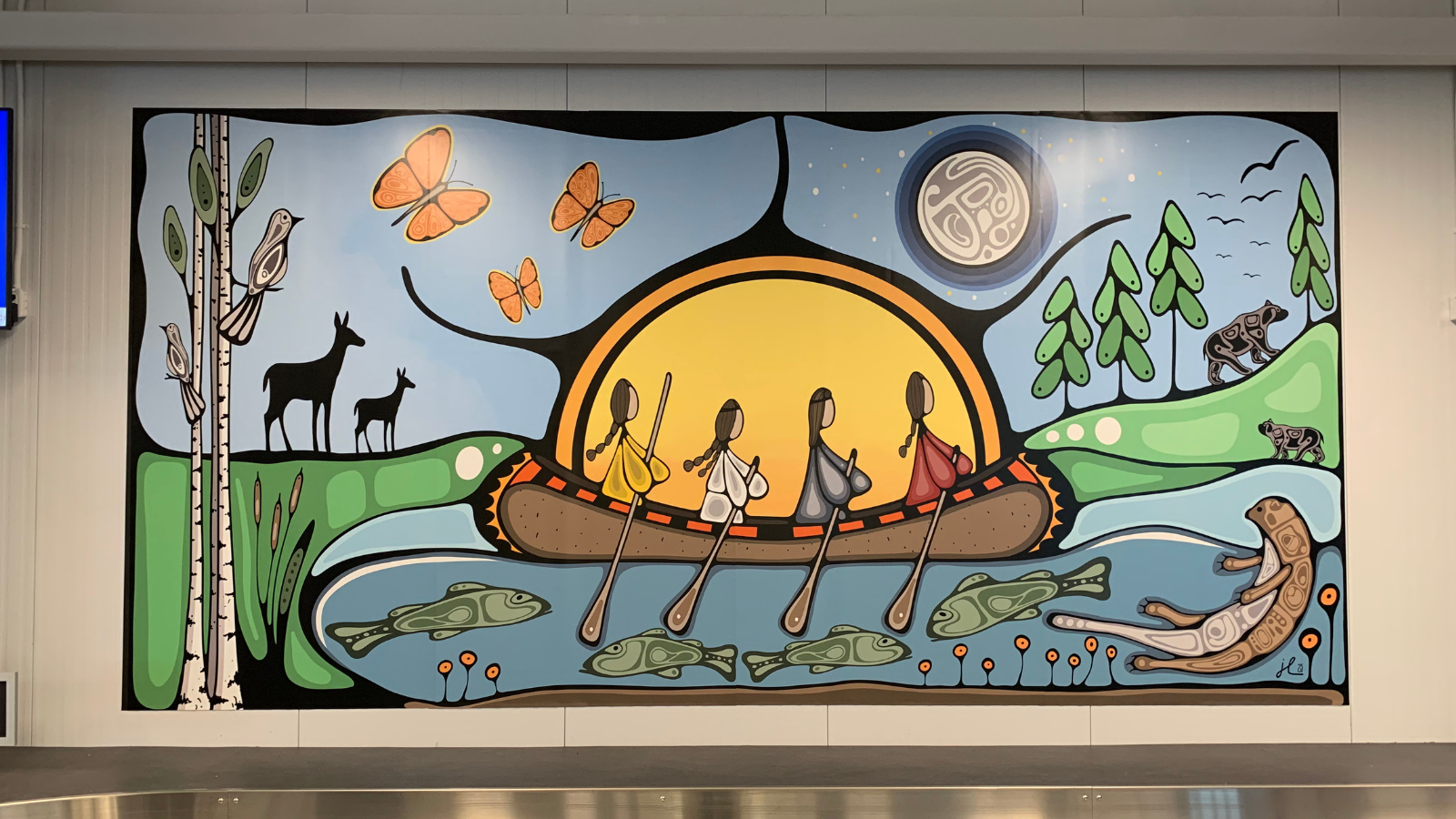 This piece reflects the deep connection between Indigenous peoples and the land and water that sustain us. Waterways—rivers, lakes, and streams—have long been the lifeblood of our communities, providing nourishment, passage, and a sacred bond with nature.
This piece reflects the deep connection between Indigenous peoples and the land and water that sustain us. Waterways—rivers, lakes, and streams—have long been the lifeblood of our communities, providing nourishment, passage, and a sacred bond with nature.
At the heart of the artwork, a canoe carrying four individuals moves forward together, symbolizing unity, community, and shared responsibility. The canoe, deeply rooted in Anishinaabe identity, connects us to the land, water, and one another. The figures are painted in the Four Sacred Directions’ colours, representing balance and harmony.
Surrounding them, five of the seven Anishinaabe clans are present—each animal embodying wisdom, protection, and tradition. They remind us of our duty to walk gently on this land and honour its gifts. This piece is a call to action: to respect, protect, and restore our environment so that future generations may thrive.
We are all one.
Grand River Prayers – Honouringour water through prayers and ceremony, 2024
Artist:Judy Ross Mack (Swampy Cree, Weenusk First Nation)
Material:Digital print
Location:YKF Domestic Arrivals Building, public space
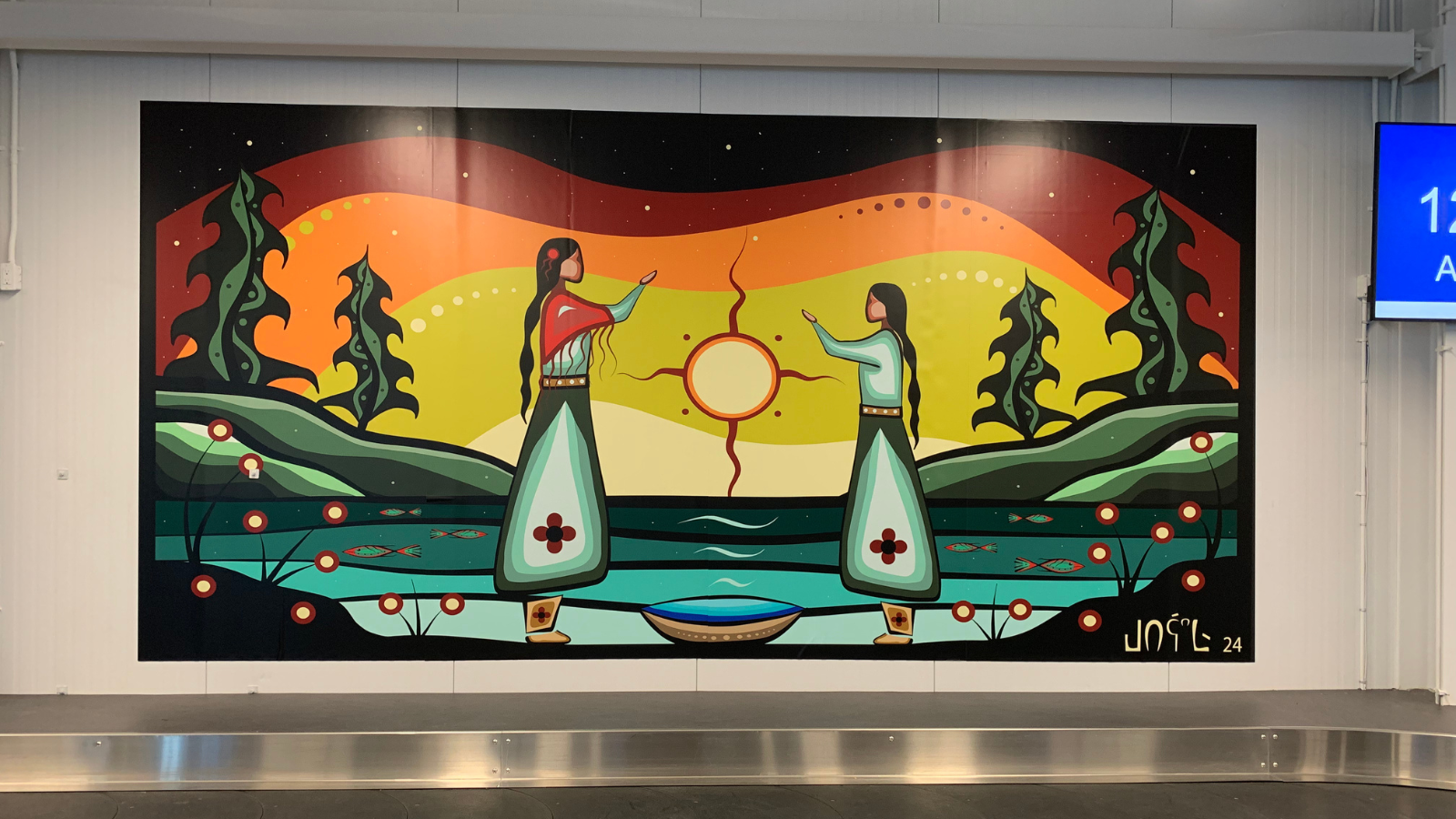 It is set by the Grand River. The two figures represent teaching, healing and ceremony. It reflects all that the Grand River offers us. It reminds us to honour our water. Take care of our water and how our water nourishes us and all living beings. It also represents the Water Walkers: Indigenous women who carried an open vessel of water and travelled great distances, bringing awareness of preservation, prayer and ceremony of the water. I have fond memories of the Grand River. It reminds me of my elder teacher and me. The way she taught me to honour the water. Taught me to heal through teaching and prayer. This reflects tradition being passed down from one generation to the next.
It is set by the Grand River. The two figures represent teaching, healing and ceremony. It reflects all that the Grand River offers us. It reminds us to honour our water. Take care of our water and how our water nourishes us and all living beings. It also represents the Water Walkers: Indigenous women who carried an open vessel of water and travelled great distances, bringing awareness of preservation, prayer and ceremony of the water. I have fond memories of the Grand River. It reminds me of my elder teacher and me. The way she taught me to honour the water. Taught me to heal through teaching and prayer. This reflects tradition being passed down from one generation to the next.

Sacred Waters, Honoured Lands, 2025
Artist:Cheyenne Ricard (Haudenosaunee, Mohawk and Tuscarora Nations)
Material:Digital print
Location:YKF Domestic Arrivals Building, public space
 This mural reflects the deep connection between people, land, and water through Haudenosaunee teachings. At its centre, the great turtle carries the Tree of Peace, symbolizing strength and unity, with the Haudenosaunee Confederacy flag flowing above, representing the bond between nations. Surrounding the turtle, people join hands, highlighting our shared duty to protect the earth. The Three Sisters—corn, beans, and squash—grow strong, symbolizing the gifts of nature and the balance of all living things. The tree’s roots intertwine with the people, reminding us of our connection to the land and water.
This mural reflects the deep connection between people, land, and water through Haudenosaunee teachings. At its centre, the great turtle carries the Tree of Peace, symbolizing strength and unity, with the Haudenosaunee Confederacy flag flowing above, representing the bond between nations. Surrounding the turtle, people join hands, highlighting our shared duty to protect the earth. The Three Sisters—corn, beans, and squash—grow strong, symbolizing the gifts of nature and the balance of all living things. The tree’s roots intertwine with the people, reminding us of our connection to the land and water.
In memory of my grandfather, Randale Clifford Murdock (Nov 11, 1944 – Feb 3, 2025), who passed during this mural’s creation. Though our lives were distant, my grandfather and I remain connected through our roots as Mohawk people. I honor his life through this painting and his place in our Haudenosaunee lineage, where every life is part of the greater whole.
Memory and the Temporal Exchange, 2017
Artist:James Nye and Amber Pacheco
Material:Acrylic on canvas, briefcase hardware
Location:YKF Domestic Arrivals Building, public space
 This sculptural painting folds up to form a piece ofluggage, andis fittingly installedabovea baggage carousel.Memory and the Temporal Exchangeis a token of the memories and experiences we carry with uson our personal journey. The artistsseekto evoke the temporal aspect of human existence and thefleeting nature of experience.Through the representational collage of images, the artists pay homage to the process of creation. The artworkserves as a window into the artists' process and experience, while the deconstruction and portabilityof the paintinginstill a narrative of falseprivacy. Our baggage, whether emotional or physical, becomes the bridge of experience between states of being.
This sculptural painting folds up to form a piece ofluggage, andis fittingly installedabovea baggage carousel.Memory and the Temporal Exchangeis a token of the memories and experiences we carry with uson our personal journey. The artistsseekto evoke the temporal aspect of human existence and thefleeting nature of experience.Through the representational collage of images, the artists pay homage to the process of creation. The artworkserves as a window into the artists' process and experience, while the deconstruction and portabilityof the paintinginstill a narrative of falseprivacy. Our baggage, whether emotional or physical, becomes the bridge of experience between states of being.
Learn more about James Nye
Learn more about Amber Pacheco
Field of Winds, 2003
Artist: Linda Covit
Material: Stainless steel, brass, aluminum with silk screened elements
Location: Outside entrance to Region of Waterloo International Airport, Breslau, public space
 Nine mobiles each have two branches of brass leaves atop a stainless steel pole. The poles ascend in height from 10 to 14 feet, creating upward movement across the sky. The branches are constructed to move in the breeze. Aluminum light posts line the walkway to the terminal building. Each supports a plaque with silk-screened text or images depicting an event from the rich history of the airport. One reads: "Mary Weber, 20 years old, learned to fly at Lexington Field and became the fifth woman in Canada to receive a pilot's licence."
Nine mobiles each have two branches of brass leaves atop a stainless steel pole. The poles ascend in height from 10 to 14 feet, creating upward movement across the sky. The branches are constructed to move in the breeze. Aluminum light posts line the walkway to the terminal building. Each supports a plaque with silk-screened text or images depicting an event from the rich history of the airport. One reads: "Mary Weber, 20 years old, learned to fly at Lexington Field and became the fifth woman in Canada to receive a pilot's licence."
Learn more about Linda Covit
Ohontsà:ke nitioné:non onkwakara’shón:’a - Our Stories from the Land, 2025
Curator: Janis Kahentóktha Bomberry
Artists: Karennotakies Barnes, Kate Dalton, Elizabeth Doxtater, Lorrie Gallant, and Sara General-Deer
Storytellers: Phil Montureand Clarence Cachagee
Location: YKF Departure Lounge, restricted area, valid boarding pass required
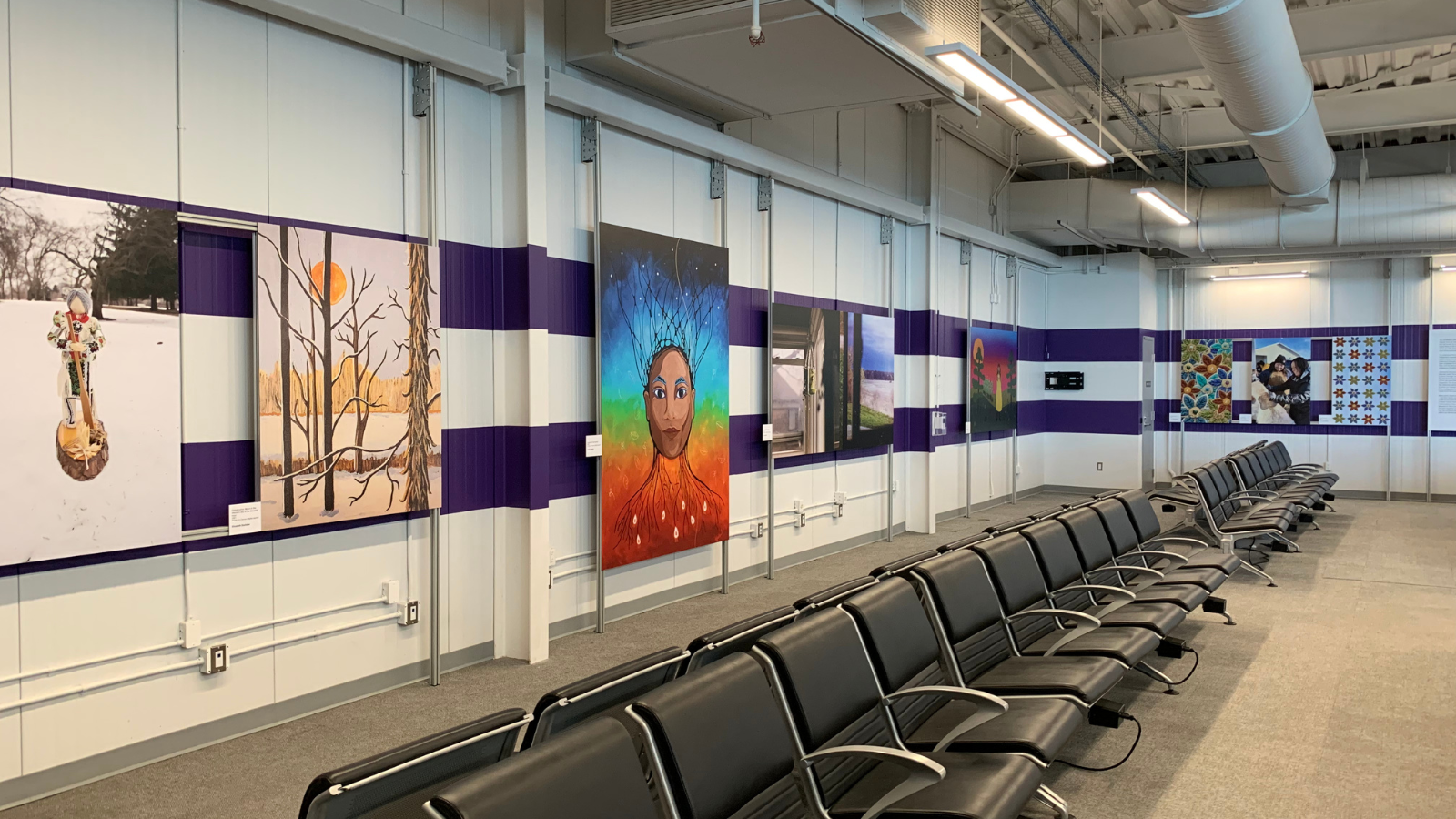 "Installed in 2025, Ohontsà:ke nitioné:non onkwakara’shón:’a - Our Stories from the Land, reflects on the stories of what is now the Region of Waterloo International Airport from an Onkwehon:wé (Original Peoples) contemporary lens. These lands are those that fall under the Haldimand Tract (treaty), which granted six miles on either side of the Grand River to the Six Nations of the Grand River, from the source to the mouth (950,000 acres), in 1784. Before, these lands fell into the 1701 Fort Albany (NANFAN) Treaty, and since time immemorial, were traditional hunting territory.
"Installed in 2025, Ohontsà:ke nitioné:non onkwakara’shón:’a - Our Stories from the Land, reflects on the stories of what is now the Region of Waterloo International Airport from an Onkwehon:wé (Original Peoples) contemporary lens. These lands are those that fall under the Haldimand Tract (treaty), which granted six miles on either side of the Grand River to the Six Nations of the Grand River, from the source to the mouth (950,000 acres), in 1784. Before, these lands fell into the 1701 Fort Albany (NANFAN) Treaty, and since time immemorial, were traditional hunting territory.
To understand the history of this Onhwèn:tsia (land) it is important to hear it from the Indigenous narrative - one that has been absent as it is usually told and understood through western and colonial narratives. The land has been inhabited for thousands of years as evidenced through archaeological excavations around this airport site. This land has long been inhabited by first the Neutrals, then the Huron and now the Six Nations of the Grand River and the Mississaugas of the Credit. Today these lands are inhabited by many Indigenous peoples from across Turtle Island (now known as North America).
Ohontsà:ke nitioné:non onkwakara’shón:’a is a Mohawk term that translates to Our Stories from the Land. This exhibit brings together Indigenous artists to share how this land relates to them through various seasons and ceremonies. Land is not to be owned but to be cared for and shared by everyone to ensure sustainability. For the Indigenous peoples, the stories of how we once lived with the land and gave thanks for all that it offered our people areis important. This honouring of our Mother Earth can be explained through the translation of the Ohén:ton Karihwatéhkwen – The Words that Come Before All Else. While it is important to know our shared history and truths; it is vital to understand the contemporary reality for those Indigenous peoples living on and around this land today. It is a story that is even less heard since the newcomers came to this land.
Many place names within Waterloo Region reflect primarily settler stories and settler names – very few names acknowledge the Original Peoples presence on this land. One thing I hope is that as time passes, we can change this absence of Indigeneity. Only through the sharing of these stories from the land can we see real change and understanding.
This exhibit is the continuation of the concepts developed in Dibaajimowin at Ken Seiling Waterloo Region Museum in 2023 curated by Emma Rain Smith (Bkejwanon/Walpole Island), which also brought together conversations and relationships through Indigenous art. It is my hope that we continue these conversations featuring Indigenous art and artists to tell stories that reflect our shared relationship to this land."
-Janis Kahentóktha Bomberry
Two Row Design
Two dark purple rows run through the exhibit, which allude to the 400-year-old agreement of peace, equity, friendship, autonomy and mutual respect between Indigenous Peoples and European settlers. The “Two Row Wampum”, also known as Teiohate Kaswenta (Mohawk), has two parallel lines that symbolize two separate paths or vessels. According to Indigenous Knowledge Keepers, these lines are said to symbolize two canoes, travelling along the river of life together, alongside each other but never interfering or overlapping in the others’ path.
Today, this design feature affirms the spirit and intent of the relationship between the Region of Waterloo and Indigenous Peoples.
Why us? Why Here? Why Now?
In preparation for the expansion of the Region of Waterloo Airport, the discovery of archaeological evidence indicates that the area is situated on land that has been rich in Indigenous cultures for thousands of years. In a 2016 report from StatsCan, it was reported that over 8,000 Indigenous peoples reside in Waterloo Region (StatsCan, 2016).
This exhibit is an Indigenous-led, contemporary reflection of historical practices and storytelling. We acknowledge the historical inequities that have harmed and oppressed the
Indigenous community, along with the continuing progress and contributions Indigenous people make in shaping Waterloo Region. We hope that this exhibit sparks your curiosity to learn more about Indigenous culture in the Region and the deeper meaning behind the connection to the land we share.
While viewing this exhibit, we invite you to acknowledge the traditions and values that connect these stories together, including respect, healing, and appreciation of the land and all it provides for us.
The artwork on display will change, recognizing that history is imperative to storytelling. Future installations will incorporate different Indigenous voices and share their stories from a different perspective.
- Region of Waterloo
Ohontsà:ke nitioné:non onkwakara’shón:’a - Our Stories from the Land is presented in partnership by the Region of Waterloo Museums and Archives and the Region of Waterloo International Airport. Generously funded by the Province of Ontario, RTO4 and the Region of Waterloo.


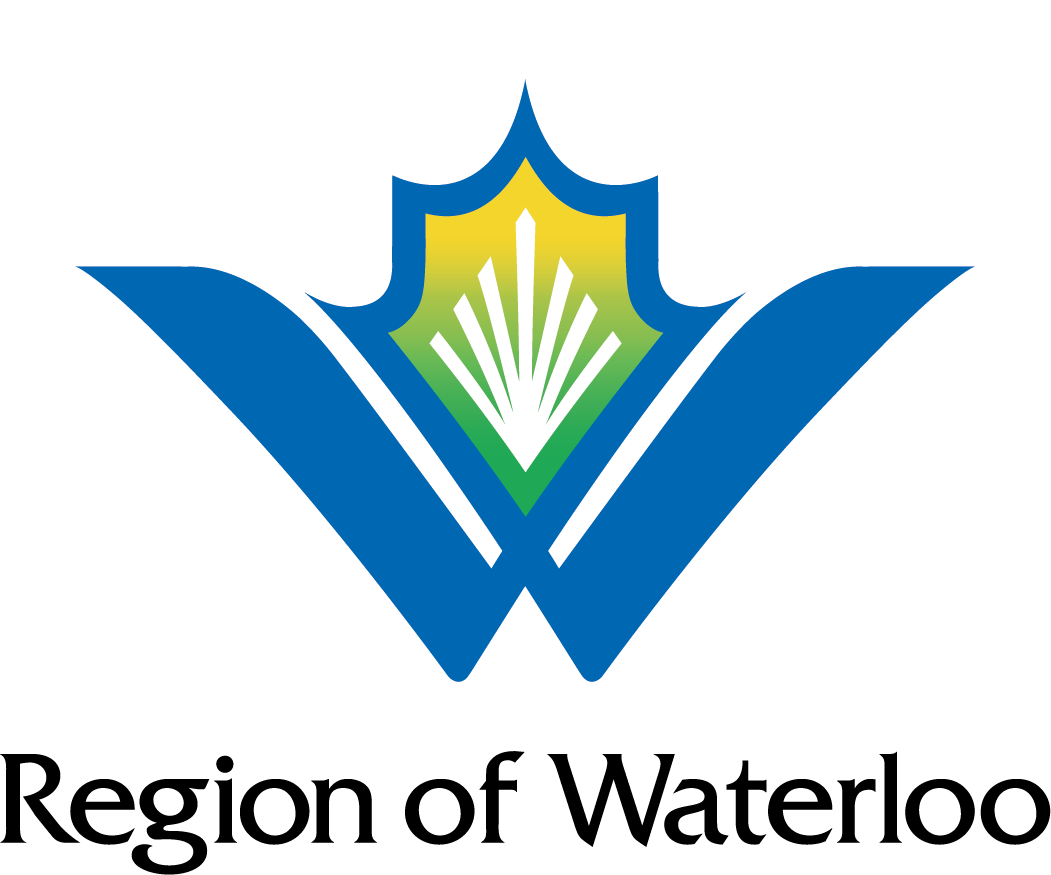
The Region of Waterloo Museums and Archives and YKF partnered to create this exhibit, funded by the Province of Ontario, Regional Tourism Office 4 and Region of Waterloo
 To learn more about public art and keep up to date with upcoming artists visit the Public Art Program page.
To learn more about public art and keep up to date with upcoming artists visit the Public Art Program page.
